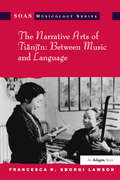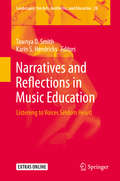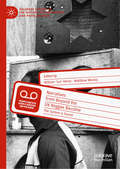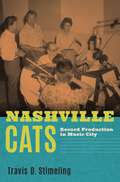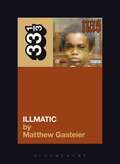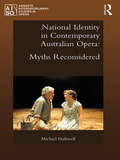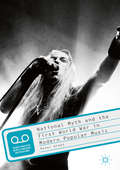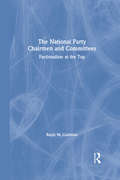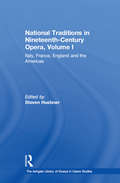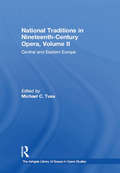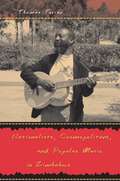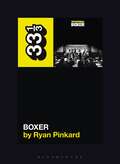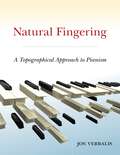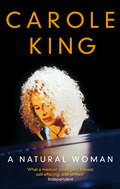- Table View
- List View
The Narrative Arts of Tianjin: Between Music and Language (SOAS Studies in Music)
by Francesca R. LawsonIn studying one of the world's oldest and most enduring musical cultures, academics have consistently missed one of the richest forms of Chinese cultural expression: performed narratives. Francesca R. Sborgi Lawson explores the relationships between language and music in the performance of four narrative genres in the city of Tianjin, China, based upon original field research conducted in the People's Republic of China in the mid 1980s and in 1991. The author emphasizes the unique nature of oral performances in China: these genres are both musical and literary and yet are considered to be neither music nor literature. Lawson employs extensive examples of the complex interaction of music and language in each genre, all the while relating those analyses to broader cultural issues and to patterns of social relationships. The narrative arts known as shuochang (speaking-singing) are depicted as genres that constitute a unique communicative discourse”the communication of stories in song. The genres subsumed under the native conception of shuochang include Tianjin Popular Tunes, Beijing Drumsong, Clappertales and Comic Routines. The maximum utilization of shuo (speaking) and chang (singing) in all their varying manifestations constitutes the vitality of the traditional narrative arts in the city of Tianjin”the center for these arts in North China. The variety of narrative forms provides entertainment for audiences representing all social strata of Chinese society. The author argues that Chinese narrative traditions represent a foundation from which certain Chinese literary and operatic traditions have borrowed, such as how the novels from the Ming-Qing period draw on the performed narrative arts both in style and in content. Hence, an understanding of performed narratives is not only useful to scholars in Chinese literature and music, but also to scholars interested in broadening their understanding of China generally.
The Narrative Arts of Tianjin: Between Music and Language (SOAS Studies in Music)
by Francesca R. LawsonIn studying one of the world's oldest and most enduring musical cultures, academics have consistently missed one of the richest forms of Chinese cultural expression: performed narratives. Francesca R. Sborgi Lawson explores the relationships between language and music in the performance of four narrative genres in the city of Tianjin, China, based upon original field research conducted in the People's Republic of China in the mid 1980s and in 1991. The author emphasizes the unique nature of oral performances in China: these genres are both musical and literary and yet are considered to be neither music nor literature. Lawson employs extensive examples of the complex interaction of music and language in each genre, all the while relating those analyses to broader cultural issues and to patterns of social relationships. The narrative arts known as shuochang (speaking-singing) are depicted as genres that constitute a unique communicative discourse”the communication of stories in song. The genres subsumed under the native conception of shuochang include Tianjin Popular Tunes, Beijing Drumsong, Clappertales and Comic Routines. The maximum utilization of shuo (speaking) and chang (singing) in all their varying manifestations constitutes the vitality of the traditional narrative arts in the city of Tianjin”the center for these arts in North China. The variety of narrative forms provides entertainment for audiences representing all social strata of Chinese society. The author argues that Chinese narrative traditions represent a foundation from which certain Chinese literary and operatic traditions have borrowed, such as how the novels from the Ming-Qing period draw on the performed narrative arts both in style and in content. Hence, an understanding of performed narratives is not only useful to scholars in Chinese literature and music, but also to scholars interested in broadening their understanding of China generally.
Narratives and Reflections in Music Education: Listening to Voices Seldom Heard (Landscapes: the Arts, Aesthetics, and Education #28)
by Tawnya D. Smith Karin S. HendricksThis volume offers chapters written by some of the most respected narrative and qualitative inquiry writers in the field of music education. The authorship and scope are international, and the chapters advance the philosophical, theoretical, and methodological bases of narrative inquiry in music education and the arts. The book contains two sections, each with a specific aim. The first is to continue and expand upon dialogue regarding narrative inquiry in music education, emphasizing how narrative involves the art of listening to and hearing others whose voices are often unheard. The chapters invite music teachers and scholars to experience and confront music education stories from multiple perspectives and worldviews, inviting an international readership to engage in critical dialogue with and about marginalized voices in music. The second section focuses on ways in which narrative might be represented beyond the printed page, such as with music, film, photography, and performative pieces. This section includes philosophical discussions about arts-based and aesthetic inquiry, as well as examples of such work.
Narratives from Beyond the UK Reggae Bassline: The System is Sound (Palgrave Studies in the History of Subcultures and Popular Music)
by William ‘Lez’ Henry Matthew WorleyThis book explores the history of reggae in modern Britain from the time it emerged as a cultural force in the 1970s. As basslines from Jamaica reverberated across the Atlantic, so they were received and transmitted by the UK’s Afro-Caribbean community. From roots to lovers’ rock, from deejays harnessing the dancehall crowd to dub poets reporting back from the socio-economic front line, British reggae soundtracked the inner-city experience of black youth. In time, reggae’s influence permeated the wider culture, informing the sounds and the language of popular music whilst also retaining a connection to the street-level sound systems, clubs and centres that provided space to create, protest and innovate. This book is therefore a testament to struggle and ingenuity, a collection of essays tracing reggae’s importance to both the culture and the politics of late twentieth and early twenty-first century Britain.
Nashville Cats: Record Production in Music City
by Travis D. StimelingThe Nashville Cats bounced from studio to studio along the city's Music Row, delivering instrumental backing tracks for countless recordings throughout the mid-20th century. Music industry titans like Chet Atkins, Anita Kerr, and Charlie McCoy were among this group of extraordinarily versatile session musicians who defined the era of the "Nashville Sound," and helped establish the city of Nashville as the renowned hub of the record industry it is today. Nashville Cats: Record Production in Music City is the first account of these talented musicians and the behind-the-scenes role they played to shape the sounds of country music. Many of the genre's most celebrated artists-Patsy Cline, Jim Reeves, Floyd Cramer, and others immortalized in the Country Music Hall of Fame and musicians from outside the genre's ranks, like Bob Dylan and Leonard Cohen, heard the call of the Nashville Sound and followed it to the city's studios, recording song after song that resonated with the brilliance of the Cats. Author Travis D. Stimeling investigates how the Nashville system came to be, how musicians worked within it, and how the desires of an ever-growing and diversifying audience affected the practices of record production. Drawing on a rich array of recently uncovered primary sources and original oral histories,Âinterviews with key players, and close exploration of hit songs, Nashville Cats brings us back into the studios of this famous era, right alongside the remarkable musicians who made it happen.
Nashville Cats: Record Production in Music City
by Travis D. StimelingThe Nashville Cats bounced from studio to studio along the city's Music Row, delivering instrumental backing tracks for countless recordings throughout the mid-20th century. Music industry titans like Chet Atkins, Anita Kerr, and Charlie McCoy were among this group of extraordinarily versatile session musicians who defined the era of the "Nashville Sound," and helped establish the city of Nashville as the renowned hub of the record industry it is today. Nashville Cats: Record Production in Music City is the first account of these talented musicians and the behind-the-scenes role they played to shape the sounds of country music. Many of the genre's most celebrated artists-Patsy Cline, Jim Reeves, Floyd Cramer, and others immortalized in the Country Music Hall of Fame and musicians from outside the genre's ranks, like Bob Dylan and Leonard Cohen, heard the call of the Nashville Sound and followed it to the city's studios, recording song after song that resonated with the brilliance of the Cats. Author Travis D. Stimeling investigates how the Nashville system came to be, how musicians worked within it, and how the desires of an ever-growing and diversifying audience affected the practices of record production. Drawing on a rich array of recently uncovered primary sources and original oral histories,Âinterviews with key players, and close exploration of hit songs, Nashville Cats brings us back into the studios of this famous era, right alongside the remarkable musicians who made it happen.
Nas's Illmatic (33 1/3)
by Matthew GasteierContradiction, the yin and the yang, the simultaneous existence of two competing realities, and the larger than life persona that depicts populist realism are at the core of Nas's debut album, Illmatic. Yet Nas's identity -as an inner-city youth, a child of hip-hop, and a Black American - predicts those philosophical quandaries as much as it does its brazen ambition. Partly because of that recklessly broad scope, the artistic impact of Illmatic was massive. The record finds its place in the greatest transition in hip hop up to that point, the spot where the streets and the charts collided.
National Identity in Contemporary Australian Opera: Myths Reconsidered (Ashgate Interdisciplinary Studies in Opera)
by Michael HalliwellOpera has been performed in Australia for more than two hundred years, yet none of the operas written before the Second World War have become part of the repertoire. It is only in the late 1970s and early 1980s that there is evidence of the successful systematic production of indigenous opera. The premiere of Voss by Richard Meale and David Malouf in 1986 was a watershed in the staging and reception of new opera, and there has been a diverse series of new works staged in the last thirty years, not only by the national company, but also by thriving regional institutions. The emergence of a thriving operatic tradition in contemporary Australia is inextricably enmeshed in Australian cultural consciousness and issues of national identity. In this study of eighteen representative contemporary operas, Michael Halliwell elucidates the ways in which the operas reflect and engage with the issues facing contemporary Australians. Stylistically these eighteen operas vary greatly. The musical idiom is diverse, ranging from works in a modernist idiom such as The Ghost Wife, Whitsunday, Fly Away Peter, Black River and Bride of Fortune, to Voss, Batavia, Bliss, Lindy, Midnight Son, The Riders, The Summer of the Seventeenth Doll and The Children’s Bach being works which straddle several musical styles. A number of operas draw strongly on musical theatre including The Eighth Wonder, Pecan Summer, The Rabbits and Cloudstreet, and Love in the Age of Therapy is couched in a predominantly jazz idiom. While some of them are overtly political, all, at least tangentially, deal with recent cultural politics in Australia and offer sharply differing perspectives.
National Identity in Contemporary Australian Opera: Myths Reconsidered (Ashgate Interdisciplinary Studies in Opera)
by Michael HalliwellOpera has been performed in Australia for more than two hundred years, yet none of the operas written before the Second World War have become part of the repertoire. It is only in the late 1970s and early 1980s that there is evidence of the successful systematic production of indigenous opera. The premiere of Voss by Richard Meale and David Malouf in 1986 was a watershed in the staging and reception of new opera, and there has been a diverse series of new works staged in the last thirty years, not only by the national company, but also by thriving regional institutions. The emergence of a thriving operatic tradition in contemporary Australia is inextricably enmeshed in Australian cultural consciousness and issues of national identity. In this study of eighteen representative contemporary operas, Michael Halliwell elucidates the ways in which the operas reflect and engage with the issues facing contemporary Australians. Stylistically these eighteen operas vary greatly. The musical idiom is diverse, ranging from works in a modernist idiom such as The Ghost Wife, Whitsunday, Fly Away Peter, Black River and Bride of Fortune, to Voss, Batavia, Bliss, Lindy, Midnight Son, The Riders, The Summer of the Seventeenth Doll and The Children’s Bach being works which straddle several musical styles. A number of operas draw strongly on musical theatre including The Eighth Wonder, Pecan Summer, The Rabbits and Cloudstreet, and Love in the Age of Therapy is couched in a predominantly jazz idiom. While some of them are overtly political, all, at least tangentially, deal with recent cultural politics in Australia and offer sharply differing perspectives.
National Myth and the First World War in Modern Popular Music (Palgrave Studies in the History of Subcultures and Popular Music)
by Peter GrantThis book looks at the role of popular music in constructing the myth of the First World War. Since the late 1950s over 1,500 popular songs from more than forty countries have been recorded that draw inspiration from the War. National Myth and the First World War in Modern Popular Music takes an inter-disciplinary approach that locates popular music within the framework of ‘memory studies’ and analyses how songwriters are influenced by their country’s ‘national myths’. How does popular music help form memory and remembrance of such an event? Why do some songwriters stick rigidly to culturally dominant forms of memory whereas others seek an oppositional or transnational perspective? The huge range of musical examples include the great chansonniers Jacques Brel and Georges Brassens; folk maestros including Al Stewart and Eric Bogle; the socially aware rock of The Kinks and Pink Floyd; metal legends Iron Maiden and Bolt Thrower and female iconoclasts Diamanda Galás and PJ Harvey.
The National Party Chairmen and Committees: Factionalism at the Top
by Andrew GoldmanThis study traces the history of the national committee chairmanships of the two major political parties in the United States, emphasizing the national conventions and presidential campaigns - where national factions often reveal themselves. Candidate and ideolological factionalism, as the evidence of this volume demonstrates, has been the principal engine of convention action. Factional conflicts have had consequences not just for the political parties but for the party system itself. The institutional history of the two national committees and their chairmanships reveals a previously unrecorded aspect of United States national party development.
The National Party Chairmen and Committees: Factionalism at the Top
by Andrew GoldmanThis study traces the history of the national committee chairmanships of the two major political parties in the United States, emphasizing the national conventions and presidential campaigns - where national factions often reveal themselves. Candidate and ideolological factionalism, as the evidence of this volume demonstrates, has been the principal engine of convention action. Factional conflicts have had consequences not just for the political parties but for the party system itself. The institutional history of the two national committees and their chairmanships reveals a previously unrecorded aspect of United States national party development.
National Traditions in Nineteenth-Century Opera, Volume I: Italy, France, England and the Americas (The Ashgate Library of Essays in Opera Studies)
by Steven HuebnerThis volume covers opera in Italy, France, England and the Americas during the long nineteenth century (1789-1914). The book is divided into four sections that are thematically, rather than geographically, conceived: Places-essays centering on contexts for operatic culture; Genres and Styles-studies dealing with the question of how operas in this period were put together; Critical Studies of individual works, exemplifying particular critical trends; and Performance.
National Traditions in Nineteenth-Century Opera, Volume I: Italy, France, England and the Americas (The Ashgate Library of Essays in Opera Studies)
by Steven HuebnerThis volume covers opera in Italy, France, England and the Americas during the long nineteenth century (1789-1914). The book is divided into four sections that are thematically, rather than geographically, conceived: Places-essays centering on contexts for operatic culture; Genres and Styles-studies dealing with the question of how operas in this period were put together; Critical Studies of individual works, exemplifying particular critical trends; and Performance.
National Traditions in Nineteenth-Century Opera, Volume II: Central and Eastern Europe (The Ashgate Library of Essays in Opera Studies)
by Michael C. TusaThis volume offers a cross-section of English-language scholarship on German and Slavonic operatic repertories of the "long nineteenth century," giving particular emphasis to four areas: German opera in the first half of the nineteenth century; the works of Richard Wagner after 1848; Russian opera between Glinka and Rimsky-Korsakov; and the operas of Richard Strauss and Janácek. The essays reflect diverse methods, ranging from stylistic, philological, and historical approaches to those rooted in hermeneutics, critical theory, and post-modernist inquiry.
National Traditions in Nineteenth-Century Opera, Volume II: Central and Eastern Europe (The Ashgate Library of Essays in Opera Studies)
by Michael C. TusaThis volume offers a cross-section of English-language scholarship on German and Slavonic operatic repertories of the "long nineteenth century," giving particular emphasis to four areas: German opera in the first half of the nineteenth century; the works of Richard Wagner after 1848; Russian opera between Glinka and Rimsky-Korsakov; and the operas of Richard Strauss and Janácek. The essays reflect diverse methods, ranging from stylistic, philological, and historical approaches to those rooted in hermeneutics, critical theory, and post-modernist inquiry.
Nationalists, Cosmopolitans, and Popular Music in Zimbabwe (Chicago Studies in Ethnomusicology)
by Thomas TurinoHailed as a national hero and musical revolutionary, Thomas Mapfumo, along with other Zimbabwean artists, burst onto the music scene in the 1980s with a unique style that combined electric guitar with indigenous Shona music and instruments. The development of this music from its roots in the early Rhodesian era to the present and the ways this and other styles articulated with Zimbabwean nationalism is the focus of Thomas Turino's new study. Turino examines the emergence of cosmopolitan culture among the black middle class and how this gave rise to a variety of urban-popular styles modeled on influences ranging from the Mills Brothers to Elvis. He also shows how cosmopolitanism gave rise to the nationalist movement itself, explaining the combination of "foreign" and indigenous elements that so often define nationalist art and cultural projects. The first book-length look at the role of music in African nationalism, Turino's work delves deeper than most books about popular music and challenges the reader to think about the lives and struggles of the people behind the surface appeal of world music.
The National's Boxer (33 1/3)
by Ryan PinkardFor fans, Boxer is a profound personal meditation. Life decisions have been based on it. Relationships have been created and dissolved by it. For the band that recorded it, Boxer symbolizes a do-or-die moment; a final, give-it-everything-you've-got effort to make it work.Released in May 2007, The National's fourth full-length is the album that saved them. It's where the Ohio-via-Brooklyn five-piece found the sound, success, and spiritual growth to become one of the most critically acclaimed bands of their time. Obsessively researched and featuring intimate interviews with the fighters who were there in the ring, Ryan Pinkard captures a transformative chapter in The National's story, revealing how their breakthrough album is deeply intertwined with their personal lives, the New York indie rock renaissance of the early aughts, and a generational experience in America.
The National's Boxer (33 1/3 #162)
by Ryan PinkardFor fans, Boxer is a profound personal meditation. Life decisions have been based on it. Relationships have been created and dissolved by it. For the band that recorded it, Boxer symbolizes a do-or-die moment; a final, give-it-everything-you've-got effort to make it work.Released in May 2007, The National's fourth full-length is the album that saved them. It's where the Ohio-via-Brooklyn five-piece found the sound, success, and spiritual growth to become one of the most critically acclaimed bands of their time. Obsessively researched and featuring intimate interviews with the fighters who were there in the ring, Ryan Pinkard captures a transformative chapter in The National's story, revealing how their breakthrough album is deeply intertwined with their personal lives, the New York indie rock renaissance of the early aughts, and a generational experience in America.
The Nation's Image: French Grand Opera As Politics And Politicized Art (PDF)
by Jane FulcherFrench grand opera, this book argues, was a different and more complex kind of theater than we ordinarily suppose. Focusing on the period of grand opera's rise, its dominance, and its final decline, Professor Fulcher shows that it was a subtly used tool of the state. Using the Opera's archives, she analyses the mechanism and goals of state intervention in the theatre and how these underwent subtle change. As she demonstrates, the official framework helped to shape not only the nature of artistic development, but also politicized the theatrical experience itself. Although concerned with the audience's understanding of the operas, this book is not narrowly a 'reception history'. Rather, it is an attempt to see the part played by grand opera in a specific social and cultural context - how it arose within larger structures and in turn reacted back finally upon them.
Natural Fingering: A Topographical Approach to Pianism
by Jon VerbalisThough incomplete at the time of his death in 1849, Chopin's Projet de méthode was nonetheless revolutionary in many respects. But with his Fundamental Pattern, Chopin announced the recognition, if not discovery, of the keyboard's extraordinary topographical symmetry and postulated a core formulation for a new "pianistic" pedagogy. More than a hundred years later the now-legendary Heinrich Neuhaus would passionately plead for this pedagogy and a pianism rooted in it. Natural Fingering explores this remarkable symmetry, significantly as it sheds light on fingering matters for the now vast catalogue of repertoire. It also examines the revolutionary impact of equal temperament on compositional key choice as well as the liberating influence of Charles Eschmann-Dumur's unique discoveries regarding symmetrical inversion. Author Jon Verbalis develops principles for a topographically-based fingering strategy that reflect a surprising compatibility of this fixed symmetrical organization with the most efficient biokinetic capabilities of the pianist's playing mechanism. He addresses previously neglected or overlooked technical aspects of pianism as they relate to movement in keyboard space generally as well as fingering specifically. Symmetrical fingerings for all the fundamental forms are presented in innovative, instructive format. The reader will also find an unusually extensive, in-depth discussion of double note challenges. Answering Neuhaus's call for the reappraisal of a certain pedagogical status quo, several chapters are devoted to the relevant implications of Chopin's Fundamental Pattern. The author also advances guidelines for a progressive implementation of natural fingering principles from the very start, as well as "retooling" for teachers and students alike. Of special note are the cross-hand major and minor scales for the earliest stages, in which the necessity of thumb under/hand over pivoting actions is eliminated. Natural Fingering is the first comprehensive discussion of fingering solutions for pianists since Hummel's monumental treatise of 1828. The book is complemented by a companion website, which serves as a supplement to the printed edition. The website features copious excerpts from the extant repertoire, extended discussions on relevant topics, and a comprehensive manual of the fundamental forms with symmetrically adjusted fingerings.
A Natural Woman: A Memoir
by Carole KingA memoir by the iconic singer-songwriter chronicling her story from her beginnings in Brooklyn through her remarkable success as one of the world's most acclaimed musical talents, to her present day as a leading performer and activist. From her marriage to Gerry Goffin, with whom she wrote dozens of songs that hit the charts, to her own achievements, notably with 'Tapestry', which remained on the charts for more than six years, to her experiences as a mother, this memoir chronicles one of music's most successful and fascinating stars. The book includes dozens of photos from King's childhood, her own family, and behind-the-scenes images from her performances over the years.
The Nature of Nordic Music
by Tim HowellThe Nature of Nordic Music explores two distinctive yet complementary understandings of the term ‘nature’: the inherent features, characters and qualities of contemporary Nordic music, and how the elemental forces of nature, the phenomena of the physical world (landscape, climate, environment), inspire and condition creativity here. Within a broader debate about the meaning of ‘Nordicness’, 12 case studies challenge our assumptions about a ‘Nordic tone’ to reveal a creative energy that is diverse and cosmopolitan in outlook. Each of the three parts of the book – ‘Identities’, ‘Images’ and ‘Environments’ – accommodates an eclectic array of musical genres (classical, popular, jazz, folk, electronic). This book will appeal to anyone interested in Nordic music and culture, especially students and researchers.
The Nature of Nordic Music
by Tim HowellThe Nature of Nordic Music explores two distinctive yet complementary understandings of the term ‘nature’: the inherent features, characters and qualities of contemporary Nordic music, and how the elemental forces of nature, the phenomena of the physical world (landscape, climate, environment), inspire and condition creativity here. Within a broader debate about the meaning of ‘Nordicness’, 12 case studies challenge our assumptions about a ‘Nordic tone’ to reveal a creative energy that is diverse and cosmopolitan in outlook. Each of the three parts of the book – ‘Identities’, ‘Images’ and ‘Environments’ – accommodates an eclectic array of musical genres (classical, popular, jazz, folk, electronic). This book will appeal to anyone interested in Nordic music and culture, especially students and researchers.
NAUSHADNAMA The Life and Music of Naushad: The Life And Music Of Naushad
by Raju BharatanNaushad is by popular consent the greatest among our film music composers, having been active for 65 years! For twenty years during that period, he ruled the field: from Rattan in 1944, he was the standard against whom every other composer tried to match himself! He didn't have much to show by way of originality after Mughal e Azam (1961), though his music never became base : it was only that the stars for whom he composed declined, the public taste changed, he became trapped in his own image as the custodian of the classical mould in film sangeet. It is a measure of the great man that he steadily refused to succumb to the market pressure. His composing abilities were never in question, but he could not give 'hits" or tunes that would appeal.When he tried to adjust, he was pathetic. Raju Bharatan is such an authority on Naushad and our film music, with so much first hand knowledge and information, a book from him on Naushad is likely to be the last word as an account of his professional life. But this book covers so much more: what the cine music filed was like from inside, how the composers were competing , how they were bad-mouthing Naushad in private, in spite of the show of public bonhomie, what devious games were played to corner awards and limelight, etc. The point is not the filmi world was so dirty; the point is that the composers created great music even in such atmosphere.
